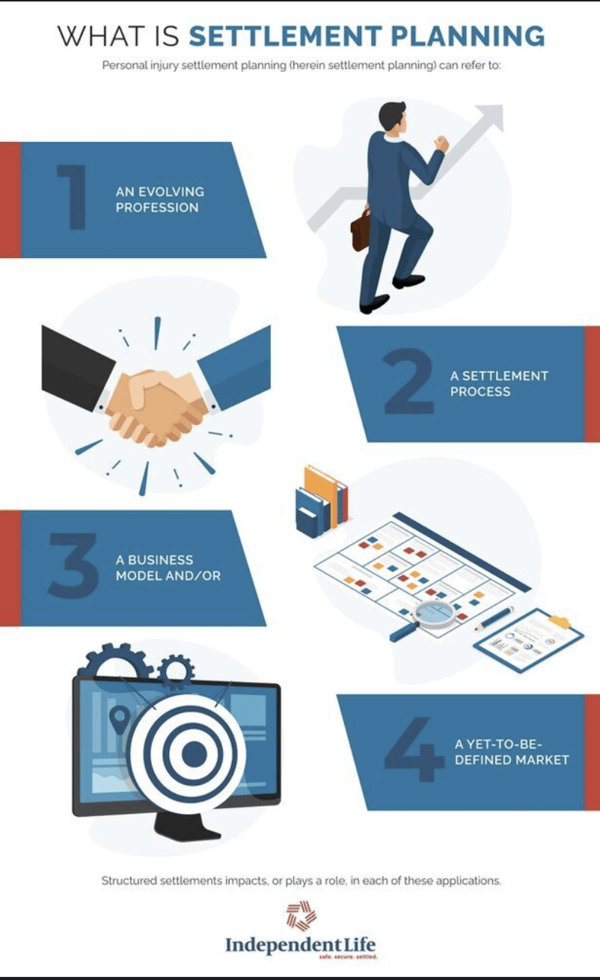What is Settlement Planning?
Settlement planning, a term previously avoided by the National Structured Settlement Trade Organization (NSSTA), was a buzz word at the 2019 NSSTA Annual Meeting, which featured an educational panel dedicated to the topic.So, as NSSTA begins “to re-think and re-design its educational programming and marketing to strategically position structured settlements as the core product within personal injury settlement planning,” a fundamental question should be: what exactly is settlement planning?
Or, more specifically, for purposes of the structured settlement market, what is personal injury settlement planning?

Profession
As structured settlements have become established parts of personal injury practice, they have altered the roles of litigating attorneys and helped created an entire new profession: personal injury settlement planning. The role of personal injury attorneys historically has encompassed settlement planning and negotiation as well as litigation.
As settlement planning has become increasingly complex, however, personal injury attorneys now require the services of other settlement planning professionals who increasingly collaborate in settlement planning teams. In specific cases, these professionals can include structured settlements consultants, life care planners, economists, tax attorneys, special needs attorneys, Medicare set-aside professionals, IRC Section 468B counsel, financial planners, registered investment advisors and other financial professionals.
Multiple national associations include settlement planning professionals among their members. The Society of Settlement Planners (SSP), through its educational conferences, certification program and Practice Standards, has provided the clearest and most consistent contribution toward developing settlement planning as a profession. However, many structured settlement professionals and special needs attorneys have also contributed to its development. NSSTA has an important educational role to play in helping its members understand and transition their practices, and the structured settlement product, as the settlement planning profession continues to evolve.
Process
By its name alone, settlement planning also suggests a process. Although not yet accepted as an industry standard the following summarized statements of the “Settlement Planning Practice Standards” approved by SSP in 2017 provide guidelines for discussion – and can be considered best practices by default until alternatives emerge.
Settlement Planning Practice Standards:
- Acknowledging the client and the settlement planner’s duty.
- Defining the scope of the engagement including making required disclosures of material conflicts of interest and details of the planner’s compensation.
- Defining the client’s goals, needs and priorities relevant to scope of engagement.
- Obtaining information and documents.
- Analyzing information to match client’s goals, needs and priorities with resources.
- Considering options and developing recommendations.
- Communicating recommendations to enable client to make informed decisions.
- Mutually agreeing on implementation responsibilities consistent with scope of assignment.
- Recommending appropriate products and services
- Mutually defining monitoring responsibilities.
As fully detailed via a PDF document the SSP website, the Settlement Planning Practice Standards deserve thoughtful study by NSSTA and its members especially to determine how best to position structured settlement annuities within this process.
Business Model
Much of the history of structured settlements has been defined by competition between two business models which can be described as the claim management or defense model and the personal injury settlement planning or plaintiff model. Structured settlements initially were promoted exclusively by defendants and their insurers as a claim management tool. Until the settlement of Weil class action lawsuit in 1996, structured settlement annuity providers typically would not appoint plaintiff structured settlement consultants as agents. For much of the industry’s history, affiliated life/liability insurer structured settlement programs and approved life company lists have represented industry standards.
Although the sale of the structured settlement was often based upon a needs-analysis approach, the defense model has typically been a single product (cash or structure) negotiation with limited or no direct contact between the defense structured settlement consultant and the injury victim and his or her family. Although originally dominated by advocates of the defense-oriented claim management model, many NSSTA members have more recently identified themselves as settlement planners.
Beginning with the formation of SSP in 2000, a new business model emerged that has challenged the constraints of the claim management model. The settlement planning model is plaintiff-driven and, arguably, more process-oriented rather than product-oriented. Most settlement planners sell financial products in addition to structured settlement annuities. They frequently maintain product neutrality and view the structured settlement annuity as a strategic product to be considered as part of a settlement planning process that typically integrates multiple products with government benefits. They frequently share structured settlement annuity commissions with defense brokers. However, they also promote IRC 468B qualified settlement funds as a settlement planning best practice in appropriate cases.
Market
In addition to its other applications, personal injury settlement planning defines a market which, in addition to its various stakeholders, consists of many complex laws, regulations and sub-markets. With a couple of exceptions, surprisingly little analysis appears to be available to define the scope and metrics of the personal injury settlement planning market or its sub-markets. One of the exceptions is the current and historic structured settlement market. Lack of analysis, however, precludes better estimates of market potential for structured settlement annuity products – whether that be in general or for specific markets such as ABLE accounts, special needs trusts, Medicare set-asides, non-qualified assignments, deferred attorney fees, etc.
From a structured settlement perspective, the lack of market research probably relates to the industry’s historic claims management negotiation view of structured settlements. A cash or structure, one and done, mentality is not pre-disposed to market analysis. When structured settlement market research has occurred, it has focused narrowly on individual purchasers (injury victims), or key influencers (plaintiff attorneys; claims professionals), rather than examining the potential market(s). As one result, future structured settlement premium projections are almost always based off of current production rather than market potential.
A series of annual studies of tort claims costs in the United States which Towers Watson published from 1985 thru 2011 provide a baseline for developing a more updated and more informative analysis of the personal injury settlement planning market. Excluding workers’ compensation, no-fault and property claims, the results of such tort costs in 2010 (the last year of the study) was $265 billion. Subtracting defense and administrative cost, this number equates to approximately $172 billion (in 2010) paid to plaintiff attorneys and their clients – compared with $6 billion of structured settlement premium in 2018.
As NSSTA and its members search for a sustainable and unifying structured settlement growth strategy, personal injury settlement planning provides many educational issues and opportunities to establish the necessary knowledge foundation.
For additional information about the historical evolution of structured settlements and personal injury settlement planning, see Chapter 1 of “Structured Settlements and Periodic Payment Judgments”.

